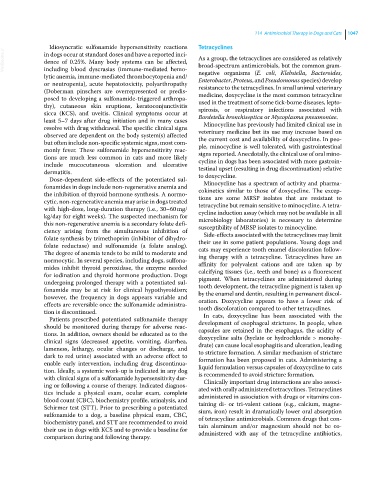Page 1109 - Clinical Small Animal Internal Medicine
P. 1109
114 Antimicrobial Therapy in Dogs and Cats 1047
Idiosyncratic sulfonamide hypersensitivity reactions Tetracyclines
VetBooks.ir in dogs occur at standard doses and have a reported inci- As a group, the tetracyclines are considered as relatively
dence of 0.25%. Many body systems can be affected,
broad‐spectrum antimicrobials, but the common gram‐
including blood dyscrasias (immune‐mediated hemo-
lytic anemia, immune‐mediated thrombocytopenia and/ negative organisms (E. coli, Klebsiella, Bacteroides,
Enterobacter, Proteus, and Pseudomonas species) develop
or neutropenia), acute hepatotoxicity, polyarthropathy resistance to the tetracyclines. In small animal veterinary
(Doberman pinschers are overrepresented or predis- medicine, doxycycline is the most common tetracycline
posed to developing a sulfonamide‐triggered arthropa- used in the treatment of some tick‐borne diseases, lepto-
thy), cutaneous skin eruptions, keratoconjunctivitis spirosis, or respiratory infections associated with
sicca (KCS), and uveitis. Clinical symptoms occur at Bordetella bronchiseptica or Mycoplasma pneumoniae.
least 5–7 days after drug initiation and in many cases Minocycline has previously had limited clinical use in
resolve with drug withdrawal. The specific clinical signs veterinary medicine but its use may increase based on
observed are dependent on the body system(s) affected the current cost and availability of doxycycline. In peo-
but often include non-specific systemic signs, most com- ple, minocycline is well tolerated, with gastrointestinal
monly fever. These sulfonamide hypersensitivity reac- signs reported. Anecdotally, the clinical use of oral mino-
tions are much less common in cats and more likely cycline in dogs has been associated with more gastroin-
include mucocutaneous ulceration and ulcerative testinal upset (resulting in drug discontinuation) relative
dermatitis. to doxycycline.
Dose‐dependent side‐effects of the potentiated sul-
Minocycline has a spectrum of activity and pharma-
fonamides in dogs include non-regenerative anemia and cokinetics similar to those of doxycycline. The excep-
the inhibition of thyroid hormone synthesis. A normo- tions are some MRSP isolates that are resistant to
cytic, non-regenerative anemia may arise in dogs treated tetracycline but remain sensitive to minocycline. A tetra-
with high‐dose, long‐duration therapy (i.e., 30–60 mg/ cycline induction assay (which may not be available in all
kg/day for eight weeks). The suspected mechanism for microbiology laboratories) is necessary to determine
this non-regenerative anemia is a secondary folate defi- susceptibility of MRSP isolates to minocycline.
ciency arising from the simultaneous inhibition of Side‐effects associated with the tetracyclines may limit
folate synthesis by trimethoprim (inhibitor of dihydro- their use in some patient populations. Young dogs and
folate reductase) and sulfonamide (a folate analog). cats may experience tooth enamel discoloration follow-
The degree of anemia tends to be mild to moderate and ing therapy with a tetracycline. Tetracyclines have an
normocytic. In several species, including dogs, sulfona- affinity for polyvalent cations and are taken up by
mides inhibit thyroid peroxidase, the enzyme needed calcifying tissues (i.e., teeth and bone) as a fluorescent
for iodination and thyroid hormone production. Dogs pigment. When tetracyclines are administered during
undergoing prolonged therapy with a potentiated sul- tooth development, the tetracycline pigment is taken up
fonamide may be at risk for clinical hypothyroidism; by the enamel and dentin, resulting in permanent discol-
however, the frequency in dogs appears variable and oration. Doxycycline appears to have a lower risk of
effects are reversible once the sulfonamide administra- tooth discoloration compared to other tetracyclines.
tion is discontinued. In cats, doxycycline has been associated with the
Patients prescribed potentiated sulfonamide therapy
should be monitored during therapy for adverse reac- development of esophageal strictures. In people, when
capsules are retained in the esophagus, the acidity of
tions. In addition, owners should be educated as to the doxycycline salts (hyclate or hydrochloride > monohy-
clinical signs (decreased appetite, vomiting, diarrhea, drate) can cause local esophagitis and ulceration, leading
lameness, lethargy, ocular changes or discharge, and to stricture formation. A similar mechanism of stricture
dark to red urine) associated with an adverse effect to formation has been proposed in cats. Administering a
enable early intervention, including drug discontinua- liquid formulation versus capsules of doxycycline to cats
tion. Ideally, a systemic work‐up is indicated in any dog is recommended to avoid stricture formation.
with clinical signs of a sulfonamide hypersensitivity dur- Clinically important drug interactions are also associ-
ing or following a course of therapy. Indicated diagnos- ated with orally administered tetracyclines. Tetracyclines
tics include a physical exam, ocular exam, complete administered in association with drugs or vitamins con-
blood count (CBC), biochemistry profile, urinalysis, and taining di‐ or tri-valent cations (e.g., calcium, magne-
Schirmer test (STT). Prior to prescribing a potentiated sium, iron) result in dramatically lower oral absorption
sulfonamide to a dog, a baseline physical exam, CBC, of tetracycline antimicrobials. Common drugs that con-
biochemistry panel, and STT are recommended to avoid tain aluminum and/or magnesium should not be co‐
their use in dogs with KCS and to provide a baseline for administered with any of the tetracycline antibiotics,
comparison during and following therapy.

